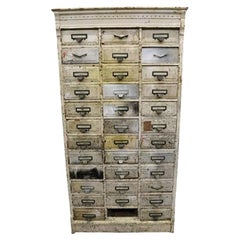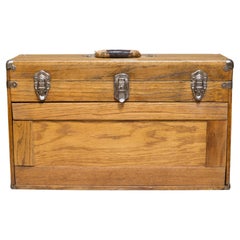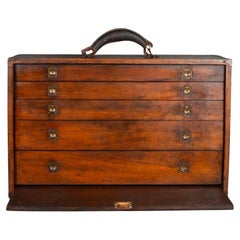Antique Machinist Chest
Late 19th Century Unknown Industrial Antique Machinist Chest
Oak
Recent Sales
Early 20th Century North American Industrial Antique Machinist Chest
Brass
Early 20th Century North American Industrial Antique Machinist Chest
Brass
Early 20th Century North American Industrial Antique Machinist Chest
Brass
Early 20th Century Industrial Antique Machinist Chest
Brass
Late 19th Century American Late Victorian Antique Machinist Chest
Brass
Early 20th Century Antique Machinist Chest
Leather, Oak
Early 20th Century North American Industrial Antique Machinist Chest
Brass
Early 20th Century Industrial Antique Machinist Chest
Silver, Brass, Enamel, Stainless Steel, Nickel
1890s American Industrial Antique Machinist Chest
Metal
Late 19th Century American Industrial Antique Machinist Chest
Oak
Early 20th Century North American Industrial Antique Machinist Chest
Metal, Steel
People Also Browsed
Early 20th Century Japanese Taisho Antique Machinist Chest
Granite
Early 20th Century French Mid-Century Modern Antique Machinist Chest
Metal
1920s American Industrial Antique Machinist Chest
Pine
1930s Czech Bauhaus Antique Machinist Chest
Chrome
20th Century Spanish Mid-Century Modern Antique Machinist Chest
Wood
Early 19th Century English High Victorian Antique Machinist Chest
Other
1970s Hong Kong Brutalist Antique Machinist Chest
Brass, Copper, Stainless Steel
Mid-20th Century Mid-Century Modern Antique Machinist Chest
Metal, Steel
Late 19th Century Italian Louis XV Antique Machinist Chest
Gold, Gold Leaf
Mid-20th Century Japanese Showa Antique Machinist Chest
Bronze
1920s Dutch Art Deco Antique Machinist Chest
Mahogany
Early 20th Century French Art Nouveau Antique Machinist Chest
Wrought Iron
1910s American Arts and Crafts Antique Machinist Chest
Iron
1950s Italian Mid-Century Modern Antique Machinist Chest
Brass
1950s Portuguese Industrial Antique Machinist Chest
Metal
Mid-19th Century British Victorian Antique Machinist Chest
Mahogany
A Close Look at Industrial Furniture
Industrial floor lamps, bar stools, desks and other industrial-style furnishings have experienced a resurgence in popularity with the rise of interest in minimalist design.
It's a look that celebrates the past even as it suggests vigor, productivity and brawn. The newly chic industrial style of decor repurposes the simple, sturdy furniture of an earlier world of commerce — brushed-metal storage cabinets and display shelves, task lamps and pendant lights with enameled shades, work tables with worn wooden tops and cast-iron bases — and couples them with aesthetic touches emblematic of energy and optimism, from bright upholstery fabrics to flowers.
The rise in prominence of the industrial style has come hand-in-hand with the residential repurposing of former manufacturing and warehouse districts throughout the United States, Canada and Europe. In many loft apartments created in shuttered factories, the architectural envelope has been left intact.
Industrial-style interiors feature elements like raw brick walls, exposed steel beams and oak floors whose history is written in every pit and gouge. Iron and glass transom windows give definition and interest to small kitchen areas anchored by kitchen islands made of marble, steel and brass, while taxidermy or vintage neon signs serve as wall art in living rooms dotted with leather club chairs. Patina is the keynote to a decor in sync with such surroundings.
On 1stDibs you will find industrial furniture designs that wear their age beautifully — and were built to last.
- 1stDibs ExpertSeptember 9, 2024To tell if a chest is antique, first examine its materials and details carefully. An antique chest is one produced 100 years ago or more. This generally predates the use of engineered wood, particleboard, plastics and other synthetic materials. As a result, an antique chest usually features solid wood construction.
In addition, antique chests are likely to be handmade, so you should be able to spot subtle signs that indicate this, such as tool marks and small irregularities in any carvings. If a piece looks flawless and regular, it is unlikely to be antique. Locating a maker's mark and then researching when the manufacturer was active can also help you date your chest. Alternatively, you can use the services of a certified appraiser or knowledgeable antique dealer to learn more about your chest.
On 1stDibs, shop a large selection of antique chests. - 1stDibs ExpertNovember 4, 2024To identify an antique chest of drawers, look inside and beneath drawers and on the back and bottom for any type of maker's marking. Researching these marks using trusted online resources may allow you to determine who produced your chest and roughly date your piece. If your chest is at least 100 years old, it is an antique. Should you be unable to locate the maker's marks, look at the hardware. Rose head nails, one-piece cast brass pommels on the drawer handles and circular rather than hexagonal bolts may all indicate that a piece is an antique. Keep in mind that hardware may have been replaced at some point and that there are many reproductions of antique furnishings. As a result, you may wish to have a certified appraiser or experienced antique dealer complete the identification process if you're unable to identify your chest via the maker's markings. Find a range of antique chests of drawers on 1stDibs.


